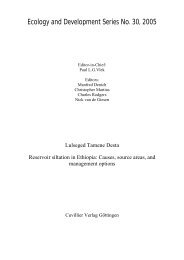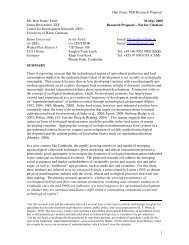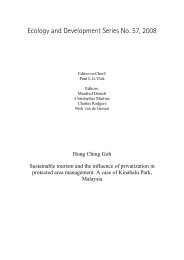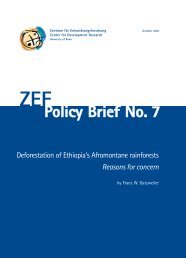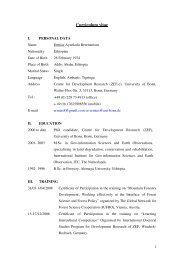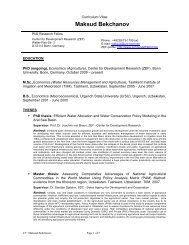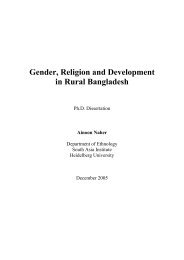Ecology and Development Series No. 10, 2003 - ZEF
Ecology and Development Series No. 10, 2003 - ZEF
Ecology and Development Series No. 10, 2003 - ZEF
- No tags were found...
You also want an ePaper? Increase the reach of your titles
YUMPU automatically turns print PDFs into web optimized ePapers that Google loves.
Conservation of the wild Coffea arabica populations in situ<strong>and</strong> 923320-934340 m N UTM). The procedures used to develop DEM <strong>and</strong> evaluationcriterion maps are presented in the next sections.6.2.2 Digital elevation model developmentThe DEM was developed from a topographic map of 1:50,000 scale obtained from theEthiopian Mapping Agency. The topographic map of the study area was scanned, <strong>and</strong> thengeo-referenced to the UTM coordinate system using the software ERDAS IMAGINE 8.5(ERDAS, Inc., Atlanta, GA, USA). The vertical interval between the contour lines of the mapis 20 m. All contour lines, peak points, depressions, <strong>and</strong> streams were digitized in ArcViewGIS (ESRI Inc., Redl<strong>and</strong>s, CA, USA). The ArcView shape files of the contour lines, peakpoints, depressions <strong>and</strong> streams were converted to Arc coverage files of the same mapprojection. The DEM was prepared from the coverage files using TOPOGRID, a DEMbuilding module built-in ARC/INFO GIS program (ESRI Inc., Redl<strong>and</strong>s, CA, USA), whichis based on the procedure developed by Hutchinson (1989). To develop the DEM, aresolution of 20 m pixel size was used. Occasionally, DEMs contain minor errors, such assinks or peaks. Sinks <strong>and</strong> peaks are errors in data due to resolution of the data or rounding ofelevations to the nearest integer value. Research has indicated that, for 30 meter resolutionDEM, 0.9 to 4.7 percent of the cells in a DEM are sinks (Eastman 2001). To improve theaccuracy of the DEM, it was made depressionless by filling the sinks using the hydrologicalmodeling extension in ArcView. By filling the sinks, the cells contained in depressions areraised to the lowest elevation value on the rim of the depression (Eastman 2001).Different data layers were generated from the DEM using the surface analysismodule in the ArcView GIS software. These include elevation, slope angle, aspect angle, <strong>and</strong>hillshade. The ArcView extension called SINMAP (Pack et al. 1998) was used to deriveslope stability <strong>and</strong> wetness indices. The aspect angle was converted to continuous variablesof northness <strong>and</strong> eastness by using cosine <strong>and</strong> sine transformations, respectively. Aspect isthe direction that a slope faces, <strong>and</strong> is normally measured in degrees. Transformationconverts the aspect angle in continuous data ranging between values –1 <strong>and</strong> 1. The slopeangle was also converted to percent slope using tangent transformations <strong>and</strong> multiplying by<strong>10</strong>0.<strong>10</strong>2





